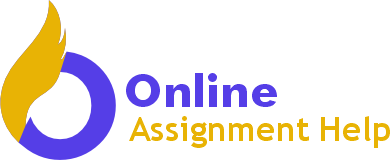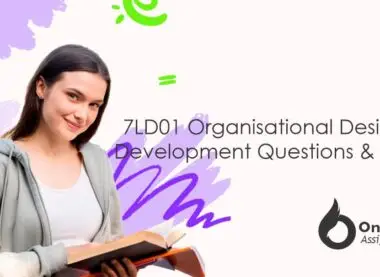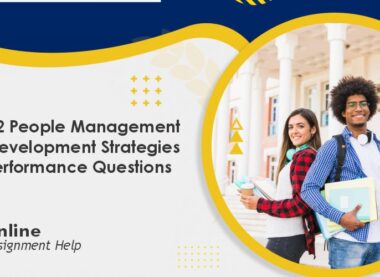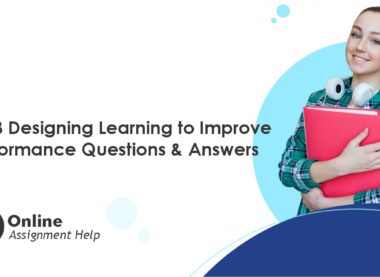Table of Contents
7LD02 Leadership and Management Development in Context Questions
Assessment questions
There is considerable evidence that management and leadership capability are paramount to organisational performance. Considering the social, economic and digital upheaval that we have all
to some extent experienced over the last few years, the Learning and Skills at Work Survey 2021 concludes that if learning is to positively impact business performance, it must get much closer to the business. As such, the L&D strategy should be aligned with the business priorities and be clear about the way learning adds value to the organisation. The survey reports that the need for learning and development is greater than ever putting the L&D professional in the spotlight. CIPD (2021).
In view of this you recognise the need to review the development of managers and leaders, updating your knowledge in this area, as a way of contributing to your organisation’s success. To demonstrate this capability, you are required to answer the following questions, fully justifying all points and recommendations made.
Question 1 (AC 1.2 & 1.3)
Critically analyse with two different organisational examples, to what extent the structure and culture of an organisation can impact the role of managers and leaders and how this can influence their learning and development needs.
Question 2 (AC 2.2 & 2.3)
Critically evaluate informal as opposed to formal learning interventions, that can be used to develop managers and leaders, recommending one formal and one informal technique that could be used to develop specific managerial and leadership competencies within your organisation or one with which you are familiar.
Question 3 (AC 3.2 & 3.3)
Critically evaluate two evaluation models that could be used to measure the impact of leadership and management development within your organisation, or one with which you are familiar, considering the challenges associated with impact measurement.
Question 4 (AC 4.3 & 4.4)
Critically analyse what additional competencies are required for managers working internationally, discussing the challenges that might arise when delivering leadership and management development across cultural and geographical boundaries.
7LD02 Assignment Answers
(AC 1.2 & 1.3) Analysis of the Extent to Which the Structure and Culture of an Organisation Can Impact the Role of Managers and Leaders and How this Can Influence their Learning and Development Needs
Organisational structure and culture significantly influence the roles and responsibilities of managers and leaders in an organisation. These elements define the framework within which a leader functions, thus influencing the processes of decision-making, their style of leadership, and, more importantly, their development (Mansouri et al. 2018).
Organisational Strategy and Structure
Google: A Case of Matrix Structure
The matrix structure used by Google has successfully integrated the functional and divisional structures to enhance flexibility and cooperation. In addition, this structure aligns with Google strategy: Innovation, and rapid product development. The matrix structure allows for the smooth flow of targets, KPIs, and objectives across different teams and projects, thus promoting an environment where managers and leaders are empowered to make their own decisions (Francom et al. 2020). It is a very crucial enabler for the culture of creativity and continuous improvement. A matrix structure supports agile methods and quick response to changes in the market and technologies.
Within this structure, the leaders and managers of Google have a broad scope to try out new things and innovate. The flexibility of the matrix structure requires excellent care in managing interdependencies and the collaborative efforts surrounding the projects (Francom et al. 2020). What this means is that collaboration capabilities are to be developed with leadership and managerial training from Google and subsequently trained in innovation management and agile project management to ensure the company’s strategic goals are met.
General Motors: A Case of Hierarchical Structure
Though General Motors operates in a more formal hierarchy with systematic lines of authority and well-defined roles, this structure can support the strategy of GM related to operational efficiency and high quality in terms of strictly controlled services that the automotive industry demands. The precise chain of command and control means that managers and leaders at GM maintain consistency and control.
This hierarchical structure could, however, imply the limitation of speed in making decisions and flexibility to changes in the market dynamics, hence hampering innovation. The leaders in GM would, therefore, require training in relevant traditional leadership skills, including strategic planning and operational management (Neto et al. 2020). The skills of being able to manage change and important to steer and implement successful strategic shifts to ensure that the firm can respond to the ever-emerging demands in the industry.
Organisational Culture and Strategic Leadership
Google: A Culture of Innovation and Openness
Google’s organisational culture is an innovation-supportive approach and openness to the workforce, facilitating the strategic intent of being a trailblazer with new technologies, maintaining an edge, and outwitting competition. This foresight culture supports the concept of autonomous leadership, where leaders are expected to be risk-takers and explore innovative ideas (Francom et al. 2020). This degree of engagement and trust of the employees in leadership will likely enhance collaboration and drive performance.
However, to sustain this culture at Google, leadership, and management must be developed with creative thinking and problem-solving skills in a manner where innovation is promoted. Training on ethical leadership is crucial for keeping the integrity of its decision-making processes and the openness and trust this firm emphasises. Training on those skills nurtures the leadership, which is sustainable to the innovative and collaborative environment driving Google’s success.
General Motors: A Culture of Efficiency and Control
GM’s culture is firmly embedded with efficiency, quality control, and compliance with processes supporting its strategic goals: operational excellence and customer satisfaction. This culture views the leadership essence to be controlling and precise to be as per required standards and protocols (Neto et al. 2020). It is essential to communicate the organisational goals and purpose clearly because that will lead to the alignment of efforts and focus.
GM aligns with that model through a focus on training in operational excellence and quality management. Development of good succession planning is firmly done to ensure a consistent pipeline of leaders who can maintain the standards and strategic direction of the organisation. GM builds a leadership team in these priority areas to sustain the culture of efficiency and control.
Comparative Analysis
Extent of Impact on Managerial and Leadership Roles
The influence that organisational structure and culture have on managerial and leadership roles is enormous and has a large extent of variation from Google to GM. Google has a matrix structure alongside the innovative culture; thus, the leaders and managers operate in a very autonomously and agile way (Neto et al. 2020). This dynamic setting spurs continuous learning and development on collaboration, innovation management, and ethical leadership. On the contrary, the tall and efficiency-based culture of the GM would call for close and tight leadership styles emphasising operational excellence, strategic planning, and change.
Influence on Learning and Development Needs
The organisational context deeply influences the learning and development needs of leaders and managers. At Google, the emphasis is on fostering creativity, agility, and ethical decision-making, aligning with its strategic focus on innovation. Training programs at Google are designed to enhance collaborative skills and support leaders in navigating complex project interdependencies (Kemmerling/Trampusch 2022). In contrast, GM prioritises training in operational efficiency, quality control, and traditional leadership skills. These training programs reflect GM’s strategic objectives of maintaining high standards and operational excellence, ensuring that its leaders can uphold the company’s cultural and strategic imperatives (Kemmerling/Trampusch 2022).
The structure and culture of an organisation profoundly impact the roles of managers and leaders, shaping their learning and development needs. Through the examples of Google and General Motors, this analysis demonstrates that while a matrix structure and innovative culture foster agility and autonomy, necessitating development in collaborative and creative skills, a hierarchical structure and efficiency-oriented culture demand a focus on operational excellence and control-oriented leadership. Ultimately, the alignment of organisational strategy, structure, and culture is crucial in determining the developmental needs and effectiveness of leaders and managers within an organisation.
(AC 2.2 & 2.3) Evaluation of Informal as Opposed to Formal Learning Interventions Used to Develop Managers and Leaders
The development of managers and leaders is a core ingredient that assists in achieving organisational success. This is possible by formal or informal learning interventions.
Formal Learning Interventions
Design of Leadership and Management Development Programs
Formal learning interventions are highly structured development programs intended to bring comprehensive build-up in leadership and management competencies. These usually include face-to-face workshops, MBAs, projects, secondments, coaching, mentoring, and lectures (Caldana et al. 2021). The design of these programs requires developing a timetable of activities that make maximum use of both synchronous—for example, webinars—and asynchronous—for example, forums—learning activities. It is, therefore, of significant importance in the structuring of formal learning interventions to provide some guiding principle in helping the learners identify paths to follow and at least guarantee that all critical competencies are covered (Caldana et al. 2021). For instance, the comprehensive curriculum systematically addresses various topics and skills. Another advantage of the structured formal program is that it usually leads to recognised qualifications, hence improving employment opportunities and credibility for those employed. However, these may be expensive and time-consuming and eventually exclude some people because of financial or time resources. Moreover, the rigid structure and fixed curriculum may not suit all styles and needs of learning.
Recommended Formal Technique: Coaching and Mentoring Programs
Through coaching and mentoring, formal, highly effective techniques lead to personalised development concentrated on managers and leaders. A professional program can be worked out to develop both communication and problem-solving skills through one-on-one sessions with experienced mentors or coaches. Coaching and mentoring programs must be focused and mapped to a clear set of goals and their timeline so that once expert coaches or mentors are engaged, leaders who are fluent in the language and possess problem-solving solid methodologies can act upon them—regular discussion for ongoing feedback and development opportunities (Coetzer et al. 2019). Use metrics on 360-degree feedback and performance reviews to gauge the enhancement in competencies. These programs heavily develop communication skills because they offer real-time feedback and practical strategies for improvement. In equal opportunity, mentors share their experience and guide their mentees in the best way possible, with strategies to handle very complex problems—encouraging the trainee toward intellectual and creative thinking (Coetzer et al. 2019). Including coaching and mentoring programs, the organisation is focused on its leaders and managers developing critical communication and problem-solving skills.
Informal Learning Interventions
Integration of Informal Learning
Informal learning interventions occur naturally through everyday interactions and experiences, lacking the structured framework of formal programs. Techniques such as project-based learning, action learning, work shadowing, and participation in communities of practice fall under this category. These interventions are typically more flexible and adaptable to individual needs.
The primary strength of informal learning interventions lies in their flexibility, allowing them to be tailored to individual learning styles and schedules. Additionally, learning is often directly linked to real-world tasks and challenges, enhancing its relevance and retention. Informal learning is also generally more cost-effective as it does not require formal classroom settings or extensive resources (Kittel et al. 2021). However, the lack of structure in informal learning can lead to inconsistencies and may not comprehensively cover all necessary competencies. Measuring and quantifying learning outcomes and impact is another challenge, making it difficult to assess the effectiveness of these interventions accurately.
Recommended Informal Technique: Communities of Practice
Communities of practice represent probably one of the most effective ways to guarantee informal learning. They involve bringing people with like-minded interests and objectives together for purposes of sharing knowledge and attaining common goals. Community members develop their communicative and problem-solving skills when discussing, sharing experiences, and solving problems communally.
Initiate communities of practice by identifying areas of crucial interest or challenge and then bring together relevant individuals with required expertise and experience. Digital forums, social media groups, or independent tools for interaction and collaboration could be used (Kittel et al. 2021). Regular and informal meetings or discussions are encouraged to keep sharing insights and the problem-solving process for everyday challenges. Designated facilitators of discussions assist in encouraging participation and keeping the focus on learning objectives. It is through daily practice and interaction at communities of practice that members keep improving their communication styles. The participation of people in communities of practice results not only in finding responses to their concerns but also in the development of intellectual creativity associated with critical analyses; this facilitates the development of necessary managerial and leadership competencies.
Comparative Analysis
Integration and Impact
If learning interventions in formal or informal learning are introduced, it can make a remarkable change in the development of leaders and managers within organisations. The formal learning approach is structured and supplies full scope, covering all of the necessary competencies. Meanwhile, informal learning supplies flexibility and practical application, making it feasible for natural and lively learning (Choi et al. 2019). A formal curriculum is mainly conducted in the classroom under a formal or structured program. Assessment and evaluation of formal learning is through clear metrics like exams performance reviews, and feedback from structured activities. On the contrary, informal learning occurs through self-assessment within work environments and social interaction, which makes it hard to quantify.
Appropriateness and Value
Both formal and informal learning approaches have unique advantages and are valuable in different contexts. The choice between formal and informal learning should depend on the specific competencies to be developed and the organisational context. Assessing the impact of formal learning can be done through traditional metrics such as qualifications achieved, performance reviews, and feedback from structured activities (Choi et al. 2019). In contrast, the impact of informal learning is evaluated through observational methods, self-reports, and peer feedback within communities of practice. Developing managers and leaders requires a balanced approach that incorporates both formal and informal learning interventions. Formal learning provides a structured and comprehensive framework essential for systematic competency development, while informal learning offers flexibility and practical application, fostering continuous improvement and engagement. For enhancing communication and problem-solving skills, a coaching and mentoring program (formal) and participation in communities of practice (informal) are recommended.
(AC 3.2 & 3.3) Evaluation of Models Used to Measure the Impact of Leadership and Management Development Within My Organisation
Impact assessment of leadership and management development programs can be critical so that investments by an organisation are realizable. Different models have been designed for the measurement of this impact, each having strengths and weaknesses.
Evaluation Models
Kirkpatrick Model
The Kirkpatrick Model is one of the most frequently utilised models in evaluating training programs. It consists of four levels used to determine the effectiveness of training. These levels are reaction, learning, behaviour, and results. The level of response is the level that determines how the participants of the training feel concerning their training by taking a record of feedback obtained by the use of surveys and questionnaires (Cahapay 2021). Learning at the second level is realised through the ascertainment of the increase in knowledge or skills by comparing the pre-training and post-training assessments. Behaviour, the third level, is an evaluation of changes in on-the-job behaviour that might have occurred because of the training, using observation, peers, and supervisor feedback.
The results tier focuses on the final results, which could be enhanced performance or profits by scrutinising KPIs like productivity, employee satisfaction, and turnover rate. The comprehensive approach of the Kirkpatrick Model captures multiple dimensions of training effectiveness (Cahapay 2021). It provides a structured framework for measurement to ensure that all the critical aspects are done systematically. Moreover, the model often leads to recognised qualifications which enhance career prospects and credibility for the participants. However, implementing the Kirkpatrick Model can be resource-intensive, for a lot of time and resources are required to gather and analyse data at all four levels. Another challenge can be the period that elapses between the training and the observable results. It further complicates the measurement process and can lead to delayed realisation of training benefits.
Success Case Method (SCM)
The Success Case Method, developed by Robert Brinkerhoff, focuses on the best and worst cases of success within a training program to understand the reasons why. This is a dual approach, combining methods of qualitative and quantitative at the same time when gauging detailed perspectives of training program effectiveness (Manville et al. 2019). The process starts with selecting a sample of the participants into two categories, success and failure cases, which are based on performance measures. Then, in-depth interviews are conducted to explore the factors contributing to success or failure. This data is then analysed, comparing successful cases against less successful ones to identify the best practices and areas for improvement. This presents an essential benefit for the SCM, as it offers an opportunity for deeper insights into generating concrete recommendations for improving training programs (Manville et al. 2019). At a detailed level, the method through interviews is rich in capturing factors that drive success. The technique also bears some limitations. It is pretty qualitative and based on data that are subjective by nature; the focus on a small sample may not be representative of the whole participant group, hence lowering the generalizability of the findings.
Challenges Associated with Impact Measurement
Time Lag
One significant challenge in measuring the impact of leadership and management development is the time lag between training delivery and observable outcomes. Leadership and management skills often take time to develop and manifest in measurable results, such as improved team performance or higher employee satisfaction (Mikalef/Gupta 2021). This delay can make it difficult to link improvements directly to the training program, complicating the evaluation process.
To address the implications of delayed results, organisations need to implement ongoing evaluation processes to track long-term changes and outcomes. Conducting longitudinal studies over extended periods can help capture the long-term impact of training. Additionally, using interim assessments to measure progress at various stages post-training can provide insights into the ongoing development of skills and behaviours.
Cultures of Unaccountability
A culture of unaccountability can significantly hinder the effectiveness of impact measurement. If managers and leaders are not held accountable for applying what they’ve learned, it becomes challenging to assess the true impact of training programs (Mikalef/Gupta 2021). This lack of accountability can lead to inconsistent application of new skills and behaviours, skewing evaluation results and reducing participants’ motivation to apply their learning if they do not perceive any consequences for failing to do so. To mitigate these issues, organisations should set clear expectations for behaviour and performance post-training. Implementing accountability mechanisms such as performance reviews and follow-up coaching can help ensure that participants are held responsible for applying their new skills and behaviours. By fostering a culture of accountability, organisations can enhance the effectiveness of their training programs and ensure that the desired outcomes are achieved.
Comparative Analysis of Models
Comprehensive vs. Focused Evaluation
The Kirkpatrick Model and the Success Case Method are distinctly different evaluation methods of training programs. In a vast sense, its scope is bound because it evaluates different dimensions of any program’s effectiveness. It can be considered a valuable tool for organisations seeking to obtain a comprehensive understanding of their training program (Widarko/Anwarodin 2022). Still, it is costly and difficult to fully exercise due to its vast coverage. On the other hand, SCM has the most remarkable in-depth analysis as it identifies and analyses cases of success and failure. Although it gives vibrant insights and actionable feedback, using a small sample size may not draw a holistic picture of the training program.
Quantitative vs. Qualitative Data
Mainly, the Kirkpatrick Model uses qualitative primarily information in the higher levels of information—behavioural and results information—hence missing some contextual nuances. This is not overly time-intensive, and it perceives things in clear, measurable terms. However, it is usually insensitive to the subtleties of individual experiences and the factors contributing to success. Again, the SCM is based on qualitative data through in-depth interviews that are pretty rich in factors attributed to the success and the failure causation. Although such an approach is in-depth, it is also very subjective and can compromise the reliability of the findings.
Actionable Insights
Both models offer valuable insights, but their approaches differ in terms of specificity and applicability. The Kirkpatrick Model generates broad findings that can inform overall training strategy but may lack specific, actionable recommendations. In contrast, the SCM delivers actionable feedback tailored to the specific contexts of success and failure cases, making it easier to implement targeted improvements (Widarko/Anwarodin 2022). By understanding these differences, organisations can choose the model that best fits their needs and objectives.
Evaluating the impact of leadership and management development is essential but challenging. The Kirkpatrick Model and the Success Case Method offer valuable frameworks for this purpose, each with its strengths and limitations. Organisations must consider these models’ applicability to their specific contexts and challenges. Addressing issues such as time lags and cultures of unaccountability is crucial for effective impact measurement.
(AC 4.3 & 4.4) Critical Analysis of Additional Competencies Required for Managers Working Internationally and Challenges that Might Arise
In a business world that is growing global, the challenges may be different from those faced in purely domestic operating settings. They may only require more comprehensive and other competencies in the managers working in an international business. Operation in international management would require the manager to cross cultures and geographies, addressing complexities such as diverse cultural contexts, language barriers, time zone differences, and technological variations.
Complexities of International Management
Managing Across Cultural Boundaries
Practicing management across cultural boundaries implies understanding and adapting to various cultural norms, values, and behaviour. This is further complicated by variations in styles of communication, ways in which decisions are made, and ways in which conflicts are resolved (Sun et al. 2021). In this case, managers should be very vigilant in realising such cultural gaps and bridging them to stimulate proper interaction to maintain productivity. Behaviours and values may differ in that some cultures hold high regard for hierarchy and authority, while some accept individualism, collectivism, or even risk-taking. These are the key elements that a manager should understand for them to adapt their leadership style appropriately.
The communication styles differ as well: high-context cultures, for example, Japan and China, rely on implicit communication and non-verbal signs, whereas low-context cultures require blunt and direct messages, such as in the US and Germany (Sun et al. 2021). Knowing these styles and adjustments yields effective interaction. Another concern is decision-making procedures in many cultures: some are inclined toward collective decision-making, while others thread on the will of the person in authority. Managers should adjust their decision-making style to the cultural settings of the teams so that operations result in mutual understanding and consequently work smoothly.
Geographical Boundaries
Geographical boundaries introduce additional challenges such as time zone differences, technological disparities, and logistical issues. These factors can hinder real-time communication and coordination, impacting the efficiency and effectiveness of international management. Coordinating meetings and project timelines across multiple time zones requires careful planning and flexibility, while technological disparities can pose challenges in access to digital infrastructure (Rauschnabel et al. 2022). Ensuring that all team members have the necessary tools and support to perform their tasks effectively is critical for maintaining productivity.
Logistical issues, such as traveling across regions and managing dispersed teams, require robust planning and support systems to ensure seamless operations (Rauschnabel et al. 2022). Effective international management demands that managers develop strategies to overcome these geographical challenges, enabling them to lead their teams efficiently across diverse locations.
Additional Competencies for International Managers
Cultural Intelligence (CQ)
Cultural intelligence is one of the most relevant competencies for international managers. It refers to the capability of understanding and adapting to the contexts of different cultures. It supports effective interpersonal interactions and helps in minimising cultural misunderstandings. Cultural intelligence has cognitive, motivational, and behavioural components (Cahen/Borini 2020). Cognitive CQ refers to knowledge vis-à-vis other cultural norms and practices; motivational CQ refers to willingly pursuing expertise and interest in interacting with others. Behavioural CQ is the ability to adjust behaviour across various cultural environments. High cultural intelligence enables a manager to communicate more effectively across cultures, which will help minimise incomprehension. Comprehending nuances in many cultures fosters trust and rapport with international colleagues and clients (Cahen/Borini 2020). Cultural intelligence thus allows a manager to adapt his leadership style in line with expectations, increasing the flexibility and effectiveness in leadership within multicultural environments.
Advanced Communication Skills
Advanced communication skills are essential to manage across cultural and geographical boundaries. This capability involves verbal and non-verbal language and the ability to listen. There is no requirement for most professions to be multilingual, but to perform adequately at the most fundamental levels of communication, one must become knowledgeable about the application of language or have access to superior translation software. Determining the intent of body language, gestures, and any other form of non-verbal communication common in most societies is an enormous responsibility and sometimes a barrier to adequate communication (Cahen/Borini 2020). Active listening is the act of a manager being able to listen empathetically to understand the viewpoints and needs of international team members.
Challenges in Delivering Leadership and Management Development Across Boundaries
Language Barriers
Effective communication should leave no doubt in what one is trying to say so that misunderstandings should be minimal or even zero. Advanced use of communication skills helps address the conflicts that arise from cultural misunderstandings and expectations (Pellegrini et al. 2020). Good communication will develop a sense of belonging and unity in multicultural teams; hence, they will be very cooperative and effective. Language barrier—the inability to communicate in a common language—is a formidable challenge during international management. Miscommunication, because of the language differences, leads to misunderstandings and also becomes a source of reduced efficiency and conflict. Meanwhile, if there is an essential piece of information that is not communicated in the team members’ native language, then there is a very real possibility that this information may be lost or distorted. In addition, team members who are not particularly good at the primary language may feel isolated and left out, making them less committed and inefficient.
Time Zone Differences
Coordinating activities across different time zones can be challenging, affecting the ability to hold synchronous meetings and collaborate in real-time. Scheduling conflicts can arise, making it difficult to find suitable times for meetings that accommodate all time zones. This can lead to delays in decision-making and project timelines (Pellegrini et al. 2020). Moreover, team members may have to participate in meetings outside of their regular working hours, leading to fatigue and decreased productivity.
Implementing flexible scheduling practices can help accommodate different time zones and minimise inconvenience. Utilising asynchronous communication tools, such as email and collaborative platforms, allows team members to contribute at their convenience, facilitating continuous collaboration and reducing the impact of time zone differences.
Implications for Leadership and Management Development Programs
Offering language training in the primary language used would make languages easier to follow for their managers and team members. Translation services and tools would facilitate comprehension among team members, thus fostering an all-inclusive engagement of communication and collaboration.
The challenges necessitate the right competencies in a leadership and management development program tailored to the needs of international managers. Training on cultural understanding capability must be given so that the managers develop experiential development in recognising and adapting to artistic ways of doing things. Other training programs include cultural awareness workshops that enlighten the managers on the different norms, values, and practices of given cultures (Pellegrini et al. 2020). Cross-cultural simulations and role-playing, for example, provide firsthand experience in dealing with cultural differences, thus improving the artistic intelligence of managers.
Another critical area of leadership programs may be advanced communication skills. Language courses may be arranged that would enhance a manager’s fluency in critical languages, hence enabling them to communicate effectively among themselves. Arranging communication workshops based on the themes of non-verbal communication, effective listening, and the ways to communicate appropriately in a multicultural organisation would further develop the capability of the managers to lead and work well in an organisation with diversity (Pellegrini et al. 2020). Managing across cultures and geographies requires additional competencies, including cultural intelligence and advanced communication skills. Such competencies will enable a manager to navigate the complexities of practicing international management effectively, creating a basis for better communication, trust, and collaboration within multicultural teams.
References
Cahapay, Michael B. (2021): KirkPatrick Model: Its limitations as used in higher education evaluation, in: International Journal of Assessment Tools in Education, vol. 8, no. 1, pp. 135–144. Available at: https://doi:10.21449/ijate.856143.
Cahen, Fernanda/Felipe Mendes Borini (2020): International Digital Competence, in: Journal of International Management, vol. 26, no. 1, p. 100691. Available at: https://doi:10.1016/j.intman.2019.100691.
Caldana, Adriana Cristina Ferreira/João Henrique Paulino Pires Eustachio/Bárbara Lespinasse Sampaio/Maria Luiza Gianotto/Aurora Contiero Talarico/André Cavalcante Da Silva Batalhão (2021): A hybrid approach to sustainable development competencies: the role of formal, informal and non-formal learning experiences, in: International Journal of Sustainability in Higher Education, vol. 24, no. 2, pp. 235–258. Available at: https://doi:10.1108/ijshe-10-2020-0420.
Choi, Woojae/Raymond Noe/Yoonhyung Cho (2019): What is responsible for the psychological capital-job performance relationship? An examination of the role of informal learning and person-environment fit, in: Journal of Managerial Psychology, vol. 35, no. 1, pp. 28–41. Available at: https://doi:10.1108/jmp-12-2018-0562.
Coetzer, Alan/Pattanee Susomrith/Emmanuel Twumasi Ampofo (2019): Opportunities to participate in formal and informal vocational learning activities and work-related outcomes in small professional services businesses, in: Journal of Vocational Education & Training, vol. 72, no. 1, pp. 88–114. Available at: https://doi:10.1080/13636820.2019.1584637.
Francom, Gregory M./Anna Schwan/Jeremiah N. Nuatomue (2020): Comparing Google Classroom and D2L Brightspace using the Technology acceptance model, in: TechTrends, vol. 65, no. 1, pp. 111–119. Available at: https://doi:10.1007/s11528-020-00533-0.
Kemmerling, Michael/Christine Trampusch (2022): Digital power resources (DPR): the political economy of structural and infrastructural business power in digitalised) capitalism, in: Socio-economic Review, vol. 21, no. 4, pp. 1851–1876. Available at: https://doi:10.1093/ser/mwac059.
Kittel, Anne F. D./Rebecca a. C. Kunz/Tina Seufert (2021): Self-Regulation in informal workplace learning: Influence of organisational learning culture and job characteristics, in: Frontiers in Psychology, vol. 12. Available at: https://doi:10.3389/fpsyg.2021.643748.
Mansouri, Amna Ali Al/Sanjay Kumar Singh/Mehmood Khan (2018): Role of organisational culture, leadership and organisational citizenship behaviour on knowledge management, in: International Journal of Knowledge Management Studies, vol. 9, no. 2, p. 129. Available at: https://doi:10.1504/ijkms.2018.091249.
Manville, Graham/Thanos Papadopoulos/Patrizia Garengo (2019): Twenty-first century supply chain management: a multiple case study analysis within the UK aerospace industry, in: Total Quality Management and Business Excellence/Total Quality Management & Business Excellence, vol. 32, no. 7–8, pp. 869–885. Available at: https://doi:10.1080/14783363.2019.1642101.
Mikalef, Patrick/Manjul Gupta (2021): Artificial intelligence capability: Conceptualisation, measurement calibration, and empirical study on its impact on organisational creativity and firm performance, in: Information & Management, vol. 58, no. 3, p. 103434. Available at: https://doi:10.1016/j.im.2021.103434.
Neto, Mario Sacomano/Marcelo José Do Carmo/Evandro Marcos Saidel Ribeiro/Wilton Vicente Gonçalves Da Cruz (2020): Corporate ownership network in the automobile industry: Owners, shareholders and passive investment funds, in: Research in Globalisation, vol. 2, p. 100016. Available at: https://doi:10.1016/j.resglo.2020.100016.
Pellegrini, Massimiliano Matteo/Francesco Ciampi/Giacomo Marzi/Beatrice Orlando (2020): The relationship between knowledge management and leadership: mapping the field and providing future research avenues, in: Journal of Knowledge Management, vol. 24, no. 6, pp. 1445–1492. Available at: https://doi:10.1108/jkm-01-2020-0034.
Rauschnabel, Philipp A./Barry J. Babin/M. Claudia Tom Dieck/Nina Krey/Timothy Jung (2022): What is augmented reality marketing? Its definition, complexity, and future, in: Journal of Business Research, vol. 142, pp. 1140–1150. Available at: https://doi:10.1016/j.jbusres.2021.12.084.
Sun, Pei/Jonathan P. Doh/Tazeeb Rajwani/Donald Siegel (2021): Navigating cross-border institutional complexity: A review and assessment of multinational nonmarket strategy research, in: Journal of International Business Studies, vol. 52, no. 9, pp. 1818–1853. Available at: https://doi:10.1057/s41267-021-00438-x.
Widarko, Agus/M. Khoirul Anwarodin (2022): Work motivation and organisational culture on work performance: Organisational Citizenship Behavior (OCB) as mediating variable, in: Golden Ratio of Human Resources Management, vol. 2, no. 2, pp. 123–138. Available at: https://doi:10.52970/grhrm.v2i2.207.







